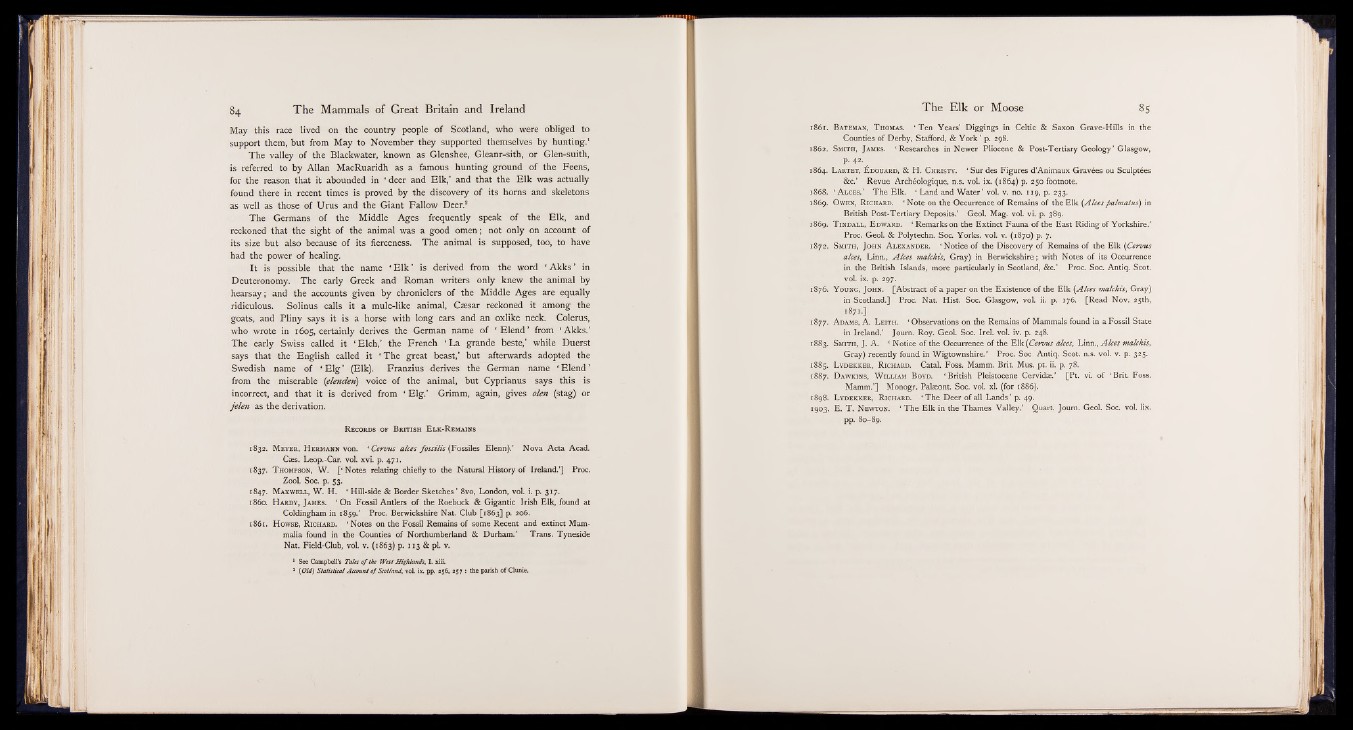
84
May this race lived on the country people of Scotland, who were obliged to
support them, but from May to November they supported themselves by hunting.1
The valley of the Blackwater, known as Glenshee, Gleanr-sith, or Glen-suith,
is referred to by Allan MacRuaridh as a famous hunting ground of the Feens,
for the reason that it abounded in ‘ deer and Elk,’ and that the Elk was actually
found there in recent times is proved by the discovery of its horns and skeletons
as well as those of Urus and the Giant Fallow Deer.2
The Germans of the Middle Ages frequently speak of the Elk, and
reckoned that the sight of the animal was a good omen; not only on account of
its size but also because of its fierceness. The animal is supposed, too, to have
had the power of healing.
It is possible that the name ‘ Elk ’ is derived from the word ‘ Akks ’ in
Deuteronomy. The early Greek and Roman writers only knew the animal by
hearsay; and the accounts given by chroniclers of the Middle Ages are equally
ridiculous. Solinus calls it a mule-like animal, Caesar reckoned it among the
goats, and Pliny says it is a horse with long ears and an oxlike neck. Colerus,
who wrote in 1605, certainly derives the German name of ‘ Elend ’ from ‘ Akks.’
The early Swiss called it ‘ Elch,’ the French ‘ La grande beste,’ while Duerst
says that the English called it ‘ The great beast,’ but afterwards adopted the
Swedish name of ‘ E lg ’ (Elk). Franzius derives the German name ‘ Elend ’
from the miserable (elenden) voice of the animal, but Cyprianus says this is
incorrect, and that it is derived from ‘ Elg.’ Grimm, again, gives olen (stag) or
jelen as the derivation.
R ecords of British E lk-Remains
1832. Meyer, H ermann von. ‘ Cervus alces fo s s ilis (Fossiles Elenn).’ Nova A c ta Acad.
Cæs. Leop.-Car. vol. xvi. p. 471.
1837. T hompson, W . [ ‘ Notes relating chiefly to the Natural History o f Ireland.’] Proc.
Z00L Soc. p. 53.
1847. Maxwell, W. H. ‘ Hill-side & Border Sketches ’ 8vo, London, vol. i. p. 317.
1860. Hardy, James. ‘ On Fossil Antlers o f the Roebuck & Gigantic Irish Elk, found at
Coldingham in 1859.’ Proc. Berwickshire N a t Club [1863] p. 206.
1861. Howse, R ichard. ‘ Notes on the Fossil Remains o f some Recent and extinct Mammalia
found in the Counties o f Northumberland & Durham.’ Trans. Tyneside
Nat. Field-Club, vol. v. (1863) p. 113 & pi. v.
1 See Campbell’s Tales o f the West Highlands, I. xiii.
2 (Old) Statistical Account o f Scotland, vol. ix. pp. 356, 257 : the parish of Clunie.
1861. Bateman, T homas. ‘ Ten Years’ Diggings in Celtic & Saxon Grave-Hills in the
Counties o f Derby, Stafford, & Y o rk ’ p. 298.
1862. Smith, James. ‘ Researches in Newer Pliocene & Post-Tertiary Geolo gy’ Glasgow,
p. 42.
1864. L artet, É douard, & H. C hristy. ‘ Sur des Figures d’Animaux Gravées ou Sculptées
&c.’ Revue Archéologique, n.s. vol. ix. (1864) p. 250 footnote.
1868. ‘ A lces.’ The Elk. ‘ Land and Water’ vol. v. no. 119, p. 233.
1869. Owen, R ichard. ‘ N ote on the Occurrence o f Remains o f the E lk (A lces p a l mains) in
British Post-Tertiary Deposits.’ Geol. Mag. vol. vi. p. 389.
1869. T indall, E dward. ‘ Remarks on the Extinct Fauna o f the East Riding o f Yorkshire.’
Proc. Geol. & Polytechn. Soc. Yorks, vol. v. (1870) p. 7.
1872. S mith, John A lexander. ‘ Notice o f the Discovery o f Remains o f the E lk (Cervus
alces, Linn., A lces malchis, Gray) in Berwickshire; with Notes o f its Occurrence
in the British Islands, more particularly in Scotland, &c.’ Proc. Soc. Antiq. Scot,
vol. ix. p. 297.
1876. Y oung, John. [Abstract o f a paper on the Existence o f the Elk (A lces malchis, Gray)
in Scotland.] Proc. N a t Hist. Soc. Glasgow, vol. ii. p. 176. [Read Nov. 25th,
1871.]
1877. A dams, A . L eith. ‘ Observations on the Remains o f Mammals found in a Fossil State
in Ireland.’ Journ. Roy. Geol. Soc. Irel. vol. iv. p. 248.
1883. S mith, J. A . ‘ Notice o f the Occurrence o f the E lk (Cervus alces, Linn., A lces malchis,
Gray) recently found in Wigtownshire.’ Proc. Soc Antiq. S c o t n.s. vol. v. p. 325.
1885. L ydekker, R ichard. Catal. Foss. Mamm. Brit. Mus. pt. ii. p. 78.
1887. D awkins, W illiam Boyd. ‘ British Pleistocene Cervidæ.’ [Pt. vi. o f ‘ Brit. Foss.
Mamm.’] Monogr. Palæont. Soc. vol. xl. (for 1886).
1898. L ydekker, R ichard. ‘ T h e Deer o f all Lands’ p. 49.
1903. E. T . N ewton. ‘ T he E lk in the Thames Valley.’ Quart. Journ. Geol. Soc. vol. lix.
pp. 80-89.